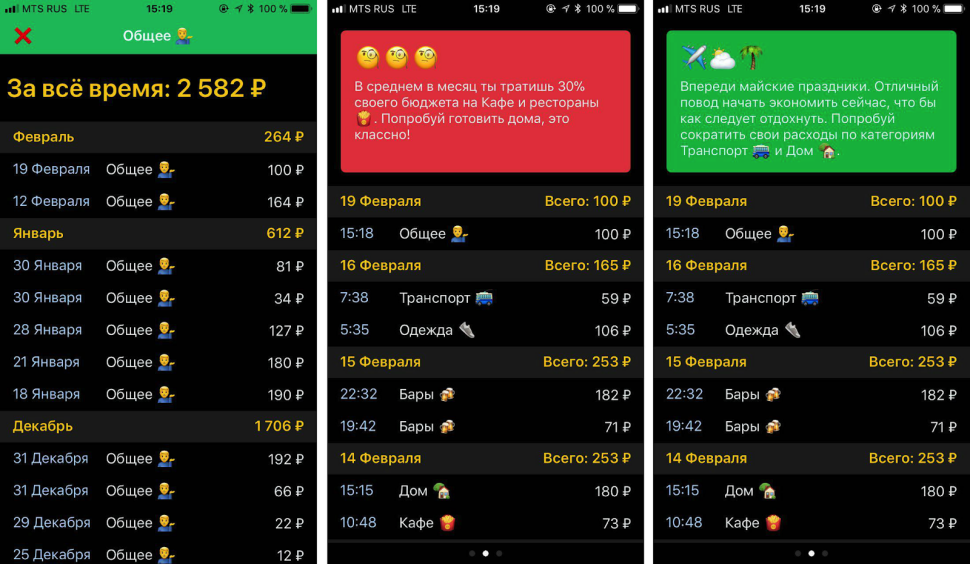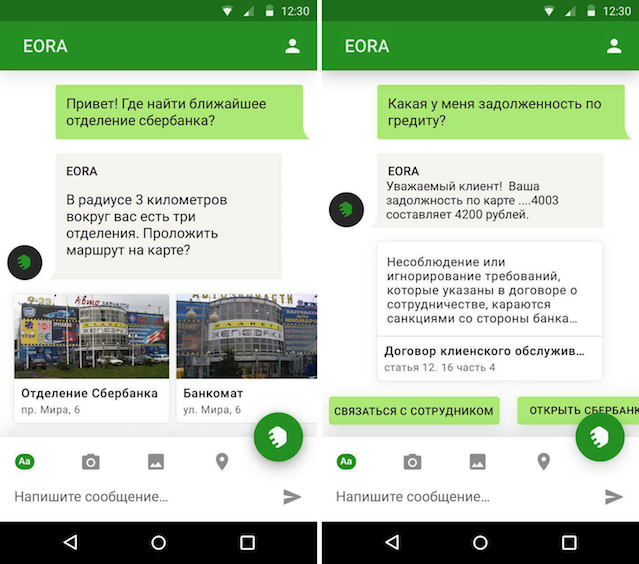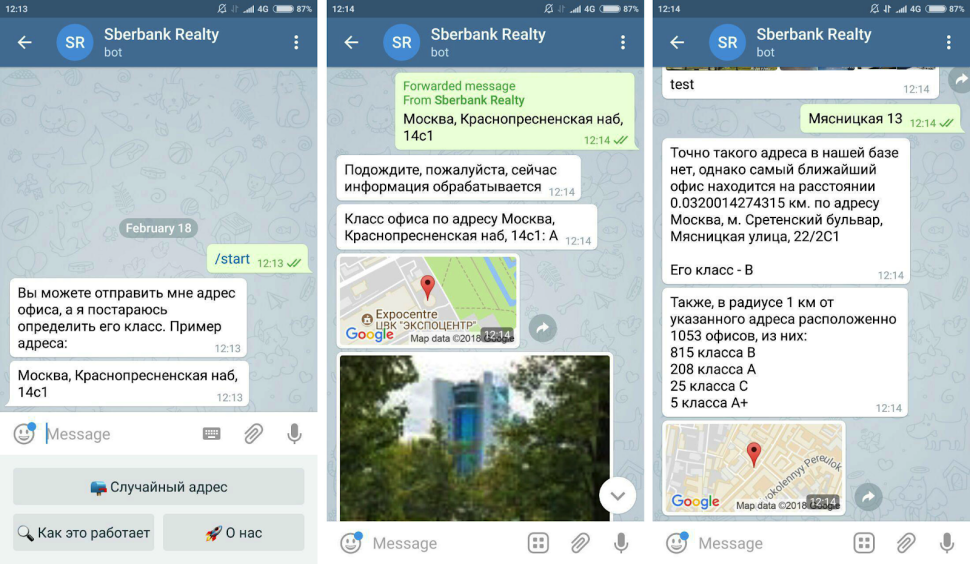Best hackathon ravers: big data and mobile development
Last week we held a big Cradle: Rave conference in Skolkovo. They organized a lot of speeches on various topics, and another three-day hackathons on Big Data and mobile development. In this post we will talk about the best ideas from those that generated more than 25 teams from Moscow, Samara and Innopolis.

We evaluated the solution of problems in accordance with what we ourselves are striving for at SberTech. The main criteria are relevance, scalability for 20 million users, relative ease of implementation and development of functionality. We also took into account the originality of the approach and the technical component, the level of implementation of the prototype and the presentation of the teams.
')
On the hackathon on mobile development, we expected three applications from the participants:
The third place was taken by the Moscow ITiger team with the SberPhone app on iOS and Android. It provides financial and navigation information: where is the nearest ATM, how to get a loan, whether it is possible to make a deposit. Also in SberPhone there is a messenger with the function of audio and video calls, voice chat-bot and data encryption. The application turned out quite good and solid to launch on the market.

In second place was the Save Money team with a financial planner for students. The application helps to plan the budget, manage expenses and financial risks. Users can set expenses / incomes, categorize expenses, plan purchases. To simplify the work, the scheduler gives hints. During the hackathon, the project was developed from scratch, without using third-party frameworks.

First place on the hackathon on mobile development did not get to anyone. The jury members did not see in any project at the same time the originality of the idea and execution itself, as well as the use of innovations. Basically, all participants showed designers from ready-made frameworks and solutions, some used their work from past hackathons. In addition, no team worked on the third task, with an interactive map of the city, which required the use of different technologies, including VR.
The hackathon participants created two products for big data:
Here the level of participants was higher than expected. With the first task, the winners coped equally well. As a result, the winner was identified by a task with optimization and various nuances.
Third place went to the GoGeo team with the gogeo_bot bot. You give the bot an address and other conditions, and in return you receive useful demographic information: how many people live in a given accessibility from the place, how much income does the population have, what is the profit of the business working there, etc. In the future, the team plans to bring the project to a full service, which will help open new points of business. GoGeo members will be very grateful if you leave feedback on their website: www.gogeo.me .

The second place is for the EORA team. She solved the task of determining the class of the office through the analysis of the comments of the seller or landlord. Of these, the system identifies the relevance of selling the office, the presence of an elevator in the building, finishing in the office itself, and other information. According to the coordinates of the building, the system determines the street, district and administrative district, and the district determines the crime rate. The system also can find the nearest metro station and the distance to it, as well as get rid of unnecessary data. Participants filled in all the blanks -1 and processed all the data using CatBoost, a machine learning model from Yandex. As a result, a result of ~ 0.9 was obtained for the f1_score macro metric - this gave second place.
The task of optimizing the transport of passengers EORA decided using linear programming. The algorithm of the team found the best route with the minimum total mileage. Restrictions were taken into account when calculating: the user can only sit in one car at a time, the driver can drive only one car, the user can be denied travel, etc. During the construction of the route, the algorithm takes into account the position of the driver and the client.

The Kanape team became the winner of the bigdata hackathon. Their chat bot for the first task seemed to the jury the best in terms of the implementation of the main functions, and a search by geolocation with voice control was added to them.
The team divided the second task into two parts. In the first part, the algorithm evaluates the distribution of orders and moves the drivers so as to effectively cover the entire territory and quickly pick up customers. In the second part, the movement of drivers with passengers is optimized so that they pick up fellow travelers on the road and carry up to four passengers at a time.

The winner of the hakaton on big data received 250 thousand rubles, the teams that took second and third places - 150 and 100 thousand, respectively.
Special thanks to our partner, IBM, for providing the IBM Data Science Experience platform (an interactive environment for collaborating on data analysis tasks)

We evaluated the solution of problems in accordance with what we ourselves are striving for at SberTech. The main criteria are relevance, scalability for 20 million users, relative ease of implementation and development of functionality. We also took into account the originality of the approach and the technical component, the level of implementation of the prototype and the presentation of the teams.
')
Mobile development
On the hackathon on mobile development, we expected three applications from the participants:
- personal financial manager with the functions of recommendations and reporting,
- instant messenger with chatbot functions, audio and video calls,
- interactive city map with branches and ATMs.
The third place was taken by the Moscow ITiger team with the SberPhone app on iOS and Android. It provides financial and navigation information: where is the nearest ATM, how to get a loan, whether it is possible to make a deposit. Also in SberPhone there is a messenger with the function of audio and video calls, voice chat-bot and data encryption. The application turned out quite good and solid to launch on the market.

In second place was the Save Money team with a financial planner for students. The application helps to plan the budget, manage expenses and financial risks. Users can set expenses / incomes, categorize expenses, plan purchases. To simplify the work, the scheduler gives hints. During the hackathon, the project was developed from scratch, without using third-party frameworks.

First place on the hackathon on mobile development did not get to anyone. The jury members did not see in any project at the same time the originality of the idea and execution itself, as well as the use of innovations. Basically, all participants showed designers from ready-made frameworks and solutions, some used their work from past hackathons. In addition, no team worked on the third task, with an interactive map of the city, which required the use of different technologies, including VR.
Big data
The hackathon participants created two products for big data:
- chat bot issuing real estate analytics in a given area based on machine learning algorithms,
- an algorithm for optimizing joint passenger traffic with a predetermined amount of resources.
Here the level of participants was higher than expected. With the first task, the winners coped equally well. As a result, the winner was identified by a task with optimization and various nuances.
Third place went to the GoGeo team with the gogeo_bot bot. You give the bot an address and other conditions, and in return you receive useful demographic information: how many people live in a given accessibility from the place, how much income does the population have, what is the profit of the business working there, etc. In the future, the team plans to bring the project to a full service, which will help open new points of business. GoGeo members will be very grateful if you leave feedback on their website: www.gogeo.me .

The second place is for the EORA team. She solved the task of determining the class of the office through the analysis of the comments of the seller or landlord. Of these, the system identifies the relevance of selling the office, the presence of an elevator in the building, finishing in the office itself, and other information. According to the coordinates of the building, the system determines the street, district and administrative district, and the district determines the crime rate. The system also can find the nearest metro station and the distance to it, as well as get rid of unnecessary data. Participants filled in all the blanks -1 and processed all the data using CatBoost, a machine learning model from Yandex. As a result, a result of ~ 0.9 was obtained for the f1_score macro metric - this gave second place.
The task of optimizing the transport of passengers EORA decided using linear programming. The algorithm of the team found the best route with the minimum total mileage. Restrictions were taken into account when calculating: the user can only sit in one car at a time, the driver can drive only one car, the user can be denied travel, etc. During the construction of the route, the algorithm takes into account the position of the driver and the client.

The Kanape team became the winner of the bigdata hackathon. Their chat bot for the first task seemed to the jury the best in terms of the implementation of the main functions, and a search by geolocation with voice control was added to them.
The team divided the second task into two parts. In the first part, the algorithm evaluates the distribution of orders and moves the drivers so as to effectively cover the entire territory and quickly pick up customers. In the second part, the movement of drivers with passengers is optimized so that they pick up fellow travelers on the road and carry up to four passengers at a time.

The winner of the hakaton on big data received 250 thousand rubles, the teams that took second and third places - 150 and 100 thousand, respectively.
Special thanks to our partner, IBM, for providing the IBM Data Science Experience platform (an interactive environment for collaborating on data analysis tasks)
Source: https://habr.com/ru/post/349730/
All Articles